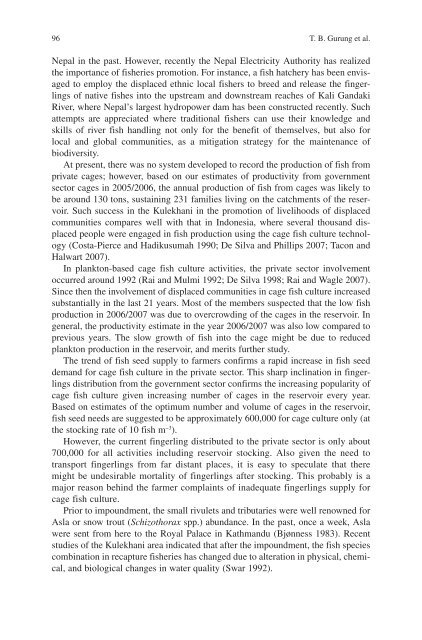Success Stories In Asian Aquaculture - Library - Network of ...
Success Stories In Asian Aquaculture - Library - Network of ...
Success Stories In Asian Aquaculture - Library - Network of ...
- No tags were found...
Create successful ePaper yourself
Turn your PDF publications into a flip-book with our unique Google optimized e-Paper software.
96 T. B. Gurung et al.Nepal in the past. However, recently the Nepal Electricity Authority has realizedthe importance <strong>of</strong> fisheries promotion. For instance, a fish hatchery has been envisagedto employ the displaced ethnic local fishers to breed and release the fingerlings<strong>of</strong> native fishes into the upstream and downstream reaches <strong>of</strong> Kali GandakiRiver, where Nepal’s largest hydropower dam has been constructed recently. Suchattempts are appreciated where traditional fishers can use their knowledge andskills <strong>of</strong> river fish handling not only for the benefit <strong>of</strong> themselves, but also forlocal and global communities, as a mitigation strategy for the maintenance <strong>of</strong>biodiversity.At present, there was no system developed to record the production <strong>of</strong> fish fromprivate cages; however, based on our estimates <strong>of</strong> productivity from governmentsector cages in 2005/2006, the annual production <strong>of</strong> fish from cages was likely tobe around 130 tons, sustaining 231 families living on the catchments <strong>of</strong> the reservoir.Such success in the Kulekhani in the promotion <strong>of</strong> livelihoods <strong>of</strong> displacedcommunities compares well with that in <strong>In</strong>donesia, where several thousand displacedpeople were engaged in fish production using the cage fish culture technology(Costa-Pierce and Hadikusumah 1990 ; De Silva and Phillips 2007 ; Tacon andHalwart 2007).<strong>In</strong> plankton-based cage fish culture activities, the private sector involvementoccurred around 1992 (Rai and Mulmi 1992 ; De Silva 1998 ; Rai and Wagle 2007) .Since then the involvement <strong>of</strong> displaced communities in cage fish culture increasedsubstantially in the last 21 years. Most <strong>of</strong> the members suspected that the low fishproduction in 2006/2007 was due to overcrowding <strong>of</strong> the cages in the reservoir. <strong>In</strong>general, the productivity estimate in the year 2006/2007 was also low compared toprevious years. The slow growth <strong>of</strong> fish into the cage might be due to reducedplankton production in the reservoir, and merits further study.The trend <strong>of</strong> fish seed supply to farmers confirms a rapid increase in fish seeddemand for cage fish culture in the private sector. This sharp inclination in fingerlingsdistribution from the government sector confirms the increasing popularity <strong>of</strong>cage fish culture given increasing number <strong>of</strong> cages in the reservoir every year.Based on estimates <strong>of</strong> the optimum number and volume <strong>of</strong> cages in the reservoir,fish seed needs are suggested to be approximately 600,000 for cage culture only (atthe stocking rate <strong>of</strong> 10 fish m −3 ).However, the current fingerling distributed to the private sector is only about700,000 for all activities including reservoir stocking. Also given the need totransport fingerlings from far distant places, it is easy to speculate that theremight be undesirable mortality <strong>of</strong> fingerlings after stocking. This probably is amajor reason behind the farmer complaints <strong>of</strong> inadequate fingerlings supply forcage fish culture.Prior to impoundment, the small rivulets and tributaries were well renowned forAsla or snow trout ( Schizothorax spp.) abundance. <strong>In</strong> the past, once a week, Aslawere sent from here to the Royal Palace in Kathmandu (Bjønness 1983) . Recentstudies <strong>of</strong> the Kulekhani area indicated that after the impoundment, the fish speciescombination in recapture fisheries has changed due to alteration in physical, chemical,and biological changes in water quality (Swar 1992) .
















